2023 SUBARU BRZ warning light
[x] Cancel search: warning lightPage 265 of 432
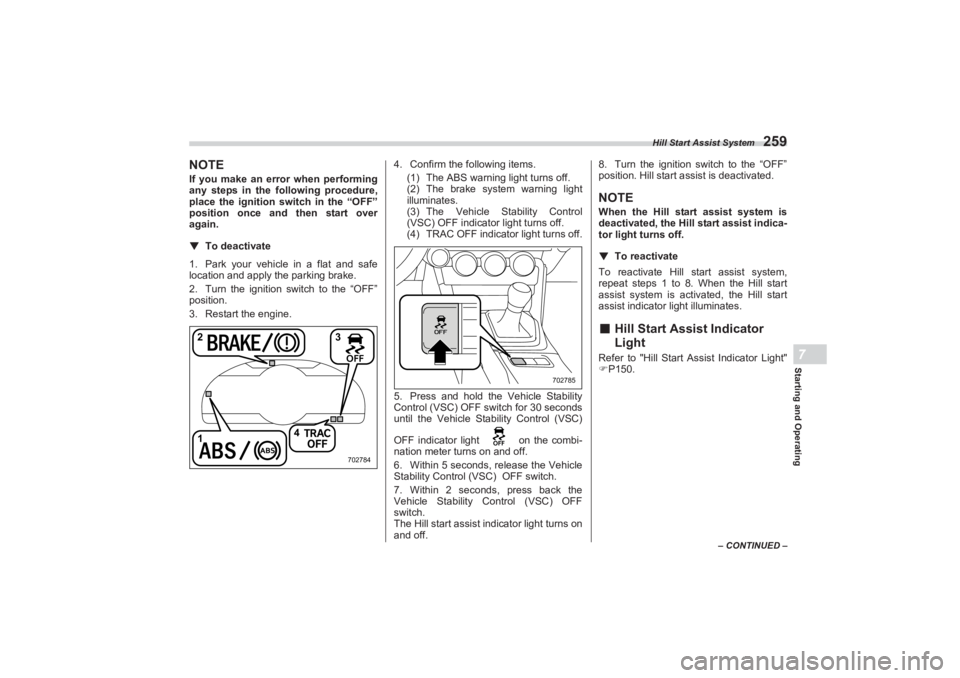
Hill Start Assist System
259
Starting and Operating7
– CONTINUED –
NOTEIf you make an error when performing
any steps in the following procedure,
place the ignition switch in the “OFF”
position once and then start over
again.▼ To deactivate
1. Park your vehicle in a flat and safe
location and apply the parking brake.
2. Turn the ignition switch to the “OFF”
position.
3. Restart the engine. 4. Confirm the following items.
(1) The ABS warning light turns off.
(2) The brake system warning light
illuminates.
(3) The Vehicle Stability Control
(VSC) OFF indicator light turns off.
(4) TRAC OFF indicator light turns off.
5. Press and hold the Vehicle Stability
Control (VSC) OFF switch for 30 seconds
until the Vehicle Stability Control (VSC)
OFF indicator light on the combi-
nation meter turns on and off.
6. Within 5 seconds, release the Vehicle
Stability Control ( VSC) OFF switch.
7. Within 2 seconds, press back the
Vehicle Stability Control (VSC) OFF
switch.
The Hill start assist i ndicator light turns on
and off. 8. Turn the ignition switch to the “OFF”
position. Hill start a ssist is deactivated.
NOTEWhen the Hill start assist system is
deactivated, the Hill start assist indica-
tor light turns off.
▼ To reactivate
To reactivate Hill start assist system,
repeat steps 1 to 8. When the Hill start
assist system is activa ted, the Hill start
assist indicator light illuminates.■ Hill Start Assist Indicator
LightRefer to "Hill Start A ssist Indicator Light"
P150.
1 4
23
702784
702785
BRZ_U.book 259 ページ 2022年3月29日 火曜日 午後3時59分
Page 266 of 432
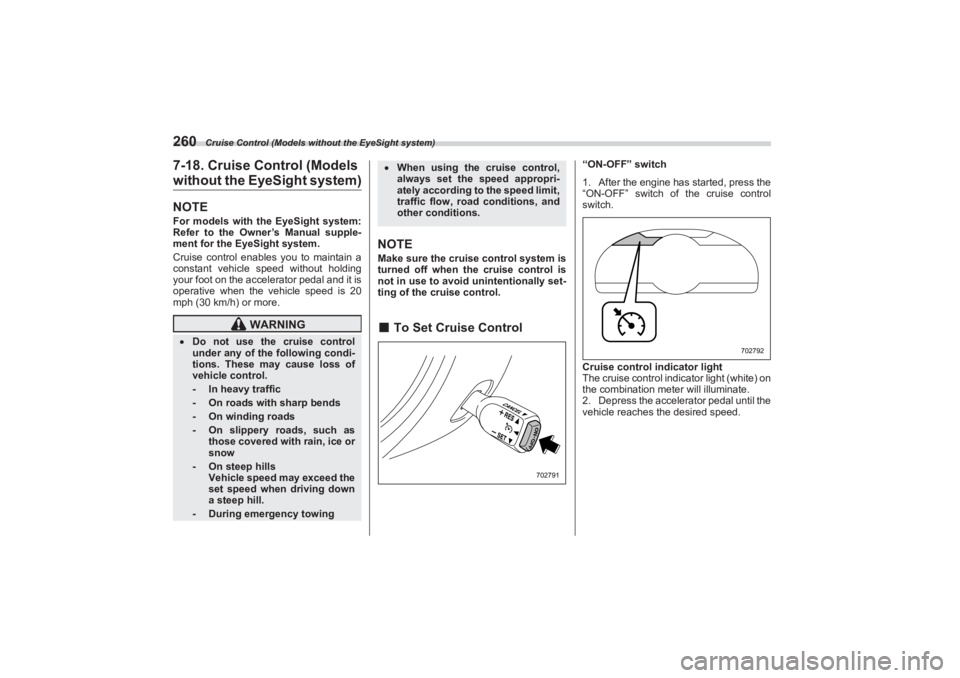
Cruise Control (Models without the EyeSight system)
2607-18. Cruise Control (Models without the EyeSight system)NOTEFor models with the EyeSight system:
Refer to the Owner’s Manual supple-
ment for the EyeSight system.
Cruise control enables you to maintain a
constant vehicle speed without holding
your foot on the accelerator pedal and it is
operative when the vehicle speed is 20
mph (30 km/h) or more.
NOTEMake sure the cruise control system is
turned off when the cruise control is
not in use to avoid unintentionally set-
ting of the cruise control.■ To Set Cruise Control
“ON-OFF” switch
1. After the engine has started, press the
“ON-OFF” switch of the cruise control
switch.
Cruise control indicator light
The cruise control indicator light (white) on
the combination meter will illuminate.
2. Depress the accelerator pedal until the
vehicle reaches the desired speed.
WARNING
Do not use the cruise control
under any of the following condi-
tions. These may cause loss of
vehicle control.
- In heavy traffic- On roads with sharp bends- On winding roads- On slippery roads, such as
those covered with rain, ice or
snow- On steep hills
Vehicle speed may exceed the
set speed when driving down
a steep hill.- During emergency towing
When using the cruise control,
always set the speed appropri-
ately according to the speed limit,
traffic flow, road conditions, and
other conditions.
702791
702792
BRZ_U.book 260 ページ 2022年3月29日 火曜日 午後3時59分
Page 269 of 432
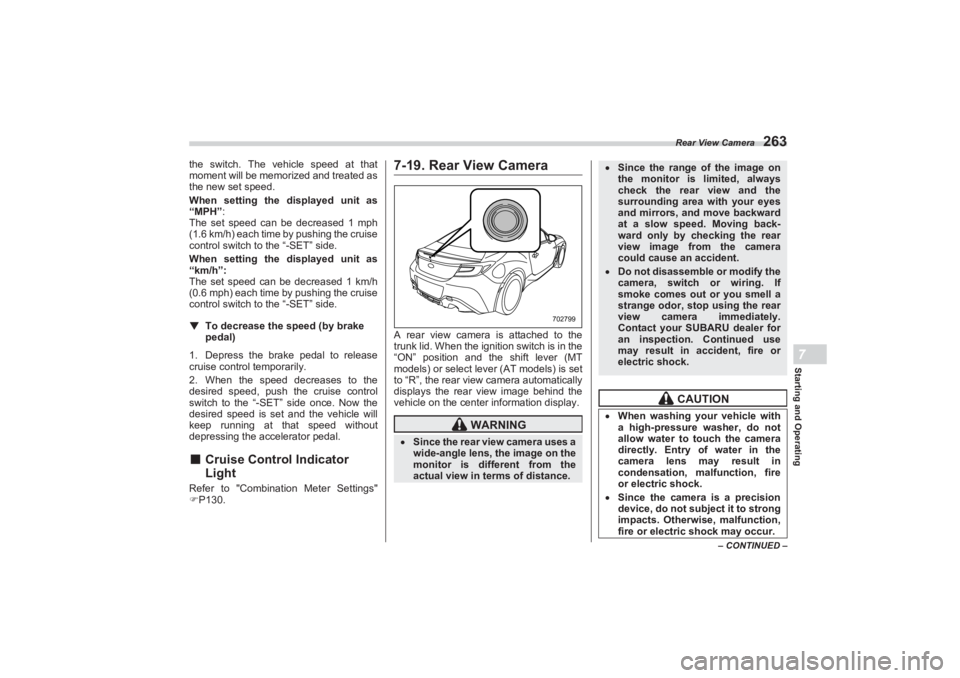
Rear View Camera
263
Starting and Operating7
– CONTINUED –
the switch. The vehicle speed at that
moment will be memorized and treated as
the new set speed.
When setting the displayed unit as
“MPH”:
The set speed can be decreased 1 mph
(1.6 km/h) each time by pushing the cruise
control switch to the “-SET” side.
When setting the displayed unit as
“km/h”:
The set speed can be decreased 1 km/h
(0.6 mph) each time by pushing the cruise
control switch to the “-SET” side.▼ To decrease the speed (by brake
pedal)
1. Depress the brake pedal to release
cruise control temporarily.
2. When the speed decreases to the
desired speed, push the cruise control
switch to the “-SET” side once. Now the
desired speed is set and the vehicle will
keep running at that speed without
depressing the accelerator pedal.■ Cruise Control Indicator
LightRefer to "Combination Meter Settings"
P130.
7-19. Rear View CameraA rear view camera is attached to the
trunk lid. When the ignition switch is in the
“ON” position and the shift lever (MT
models) or select lever (AT models) is set
to “R”, the rear view camera automatically
displays the rear view image behind the
vehicle on the center information display.
WARNING
Since the rear view camera uses a
wide-angle lens, the image on the
monitor is diffe rent from the
actual view in terms of distance.
702799
Since the range of the image on
the monitor is limited, always
check the rear view and the
surrounding area with your eyes
and mirrors, and move backward
at a slow speed. Moving back-
ward only by checking the rear
view image from the camera
could cause an accident. Do not disassemble or modify the
camera, switch or wiring. If
smoke comes out or you smell a
strange odor, stop using the rear
view camera immediately.
Contact your SUBARU dealer for
an inspection. Continued use
may result in accident, fire or
electric shock.
CAUTION
When washing your vehicle with
a high-pressure washer, do not
allow water to touch the camera
directly. Entry of water in the
camera lens may result in
condensation, malfunction, fire
or electric shock. Since the camera is a precision
device, do not subject it to strong
impacts. Otherwise, malfunction,
fire or electric shock may occur.
BRZ_U.book 263 ページ 2022年3月29日 火曜日 午後3時59分
Page 274 of 432

BSD/RCTA (If Equipped)
2687-20. BSD/RCTA (If Equipped)The BSD/RCTA consists of rear corner
radars with Blind Spot Detection and Rear
Cross Traffic Alert.
These functions of BSD/RCTA are the
systems that detect objects and vehicles
to the rear and draw attention to the driver
when changing a lane or when driving in
reverse.
■ System FeaturesBSD/RCTA consists of the following func-
tions.
To detect a vehicle in a blind spot on an
adjacent lane or a vehicle approaching at
high speed while driving the vehicle (Blind
Spot Detection)
To detect a vehicle approaching from
the right or left while reversing the vehicle
(Rear Cross Traffic Alert) The system uses radar sensors for the
following features.
NOTEThe BSD/RCTA radar sensor has been
certified by the radio wave related laws
of the U.S. and other FCC compliant
countries, Canada and Mexico. When
driving in other countries, certifica-
tion of the country where the vehicle is
driven must be obtained. For certifica-
tion in the U.S. and other FCC compli-
ant countries, Canada and Mexico,
refer to "Certification for the BSD/
RCTA" P274.
▼ Blind Spot Detection (BSD)1) Operating range
WARNING
The driver is responsible for driving
safely. Always be sure to check the
surroundings with your eyes when
changing lanes or reversing the
vehicle.
The system is designed to assist
the driver in changing lanes or
reversing safely by monitoring the
rear and side areas of the vehicle.
However, you cannot rely on this
system alone in assuring the safety
during a lane change or reversing.
Overconfidence in this system
could result in an accident and lead
to serious injury or death. Since the
system operation has various lim-
itations, the flashing or illumination
of the BSD/RCTA approach indica-
tor light may be delayed or it may
not operate at all even when a vehi-
cle is present in a neighboring lane
or approaching from either side.The driver is responsible for paying
attention to the rear and side areas
of the vehicle.
701459
1
BRZ_U.book 268 ページ 2022年3月29日 火曜日 午後3時59分
Page 275 of 432
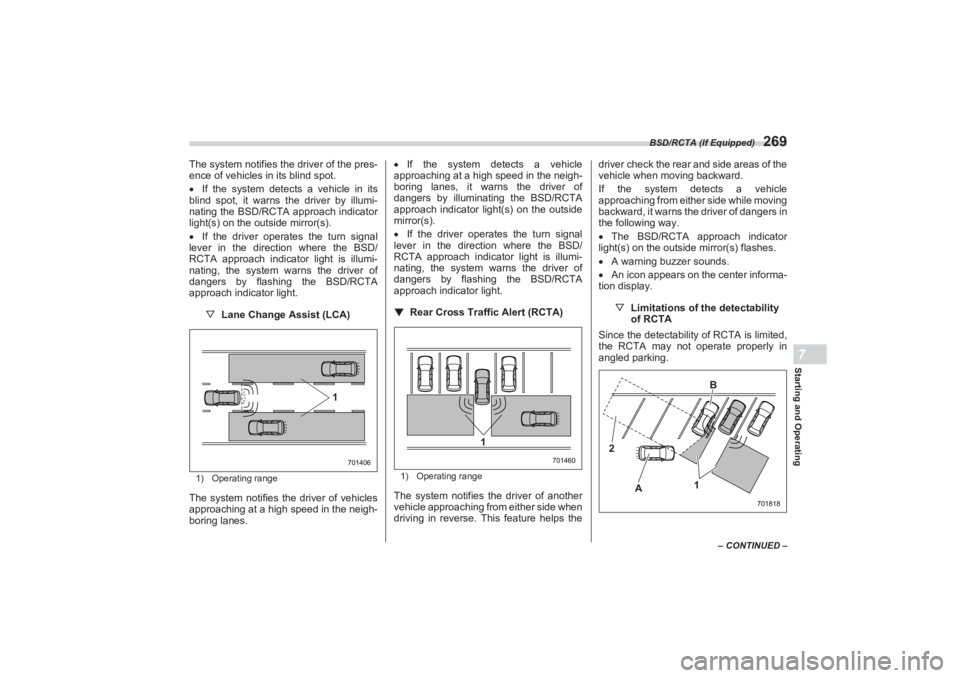
BSD/RCTA (If Equipped)
269
Starting and Operating7
– CONTINUED –
The system notifies the driver of the pres-
ence of vehicles in its blind spot.
If the system detects a vehicle in its
blind spot, it warns the driver by illumi-
nating the BSD/RCTA approach indicator
light(s) on the outside mirror(s).
If the driver operates the turn signal
lever in the direction where the BSD/
RCTA approach indicator light is illumi-
nating, the system warns the driver of
dangers by flashing the BSD/RCTA
approach indicator light.
▽ Lane Change Assist (LCA)1) Operating rangeThe system notifies the driver of vehicles
approaching at a high speed in the neigh-
boring lanes.
If the system detects a vehicle
approaching at a high speed in the neigh-
boring lanes, it warns the driver of
dangers by illuminating the BSD/RCTA
approach indicator light(s) on the outside
mirror(s).
If the driver operates the turn signal
lever in the direction where the BSD/
RCTA approach indicator light is illumi-
nating, the system warns the driver of
dangers by flashing the BSD/RCTA
approach indicator light.
▼ Rear Cross Traffic Alert (RCTA)
1) Operating rangeThe system notifies the driver of another
vehicle approaching from either side when
driving in reverse. This feature helps the driver check the rear and side areas of the
vehicle when moving backward.
If the system detects a vehicle
approaching from either side while moving
backward, it warns the driver of dangers in
the following way.
The BSD/RCTA approach indicator
light(s) on the outside mirror(s) flashes.
A warning buzzer sounds.
An icon appears on the center informa-
tion display.
▽Limitations of the detectability
of RCTA
Since the detectabilit y of RCTA is limited,
the RCTA may not operate properly in
angled parking.
701406
1
701460
1
701818
2
A B
1
BRZ_U.book 269 ページ 2022年3月29日 火曜日 午後3時59分
Page 276 of 432

BSD/RCTA (If Equipped)
270Example 1
1) The detection range of the radar
sensors
2) Area out of detection range of the radar
sensors
A) Vehicle that may not be detected
B) Parked vehicle
Example 2
1) The detection range of the radar
sensors C) Vehicle that may be detected
NOTEThe system may detect that a vehicle
(C) is passing in front of your vehicle.
Always be sure to check the
surroundings with your eyes when
reversing the vehicle.■ System Operation▼ Operating conditionsThe BSD/RCTA will operate when all of
the following conditions are met.
The ignition switch is in the “ON” posi-
tion.
The BSD/RCTA warning indicator and
BSD/RCTA OFF indicator are turned off.
The vehicle is driven at speeds above
7 mph (12 km/h) (except when reversing).
The shift lever/select lever is in the “R”
position (RCTA only).
The BSD/RCTA will not operate in the
following situations.
The BSD/RCTA OFF indicator
appears.
The vehicle speed is below 6 mph (10
km/h) even when the BSD/RCTA OFF
indicator does not appear (except when
reversing).
NOTE In the following cases, the BSD/
RCTA will stop operating and the BSD/
RCTA warning indicator will appear. - When a malfunction occurs in
the system, including the BSD/
RCTA approach indicator light
If the BSD/RCTA warning indicator
appears, exercise proper caution. For
details, refer to "BSD/RCTA Warning
Indicator" P274.
In the following cases, the BSD/
RCTA will temporarily stop operating
(or may stop operating) and the BSD/
RCTA OFF indicator will appear. - When the radar sensor becomes
significantly misali gned (If the orien-
tation of the radar sensor is shifted
for any reason, readjustment is
required. Have the sensor adjusted
at a SUBARU dealer.)
- When a large amount of snow or
ice sticks to the rear bumper surface
around the radar sensors
- When the vehicle is driven on a
snow-covered road or in an environ-
ment in which there are no objects
around (such as in a desert) for a
prolonged period of time
- When the temperature around
the radar sensors increases exces-
sively due to long driving on uphill
grades in the summer, etc.
WARNING
An approaching vehicle (A) may not
be detected because the detection
range is limited by the parked vehi-
cle (B). Always be sure to check the
surroundings with your eyes when
reversing the vehicle.
701819
1
C
BRZ_U.book 270 ページ 2022年3月29日 火曜日 午後3時59分
Page 277 of 432

BSD/RCTA (If Equipped)
271
Starting and Operating7
– CONTINUED –
- When the temperature around
the radar sensors becomes
extremely low
- When the vehicle battery voltage
lowers
- When the vehicle voltage
exceeds the battery voltage rating
The BSD/RCTA will resume operation
once these conditions are corrected,
and the BSD/RCTA OFF indicator will
disappear. However, if the BSD/RCTA
OFF indicator appears for a prolonged
period of time, have the system
inspected at a SUBARU dealer as soon
as possible.
The detectability of the radar
sensors is restricted. The BSD/RCTA
detection may be impaired and the
system may not operate properly
under the following conditions. - When the rear bumper around
the radar sensors is distorted
- When ice, snow or mud adheres
to the rear bumper surface around
the radar sensors
- When stickers, etc. are affixed on
the areas of the radar sensors on the
rear bumper
- During adverse weather condi-
tions such as rain, snow or fog
- When driving on wet roads such
as snow-covered roads and through
puddles
The radar sensors may not detect or
may have difficulty detecting the
following vehicles and objects. - Small motorcycles, bicycles,
pedestrians, stationary objects on
the road or road side, etc.
- Vehicles with body shapes that
the radar may not reflect (vehicles
with lower body height such as a
trailer with no cargo and sports
cars)
- Vehicles that are not
approaching your vehicle even
though they are in the detection area
(either on a neighboring lane to the
rear or beside your vehicle when
reversing) (The system determines
the presence of approaching vehi-
cles based on data detected by the
radar sensors.)
- Vehicles traveling at signifi-
cantly different speeds
- Vehicles driving in parallel at
almost the same speed as your
vehicle for a prolonged time
- Oncoming vehicles
- Vehicles in a lane beyond the
neighboring lane
- Vehicles travelling at a signifi-
cantly lower speed that you are
trying to overtake
On a road with extremely narrow
lanes, the system may detect vehicles driving in a lane next to the neigh-
boring lane.
■
BSD/RCTA Approach Indi -
cator Light/Warning BuzzerWhile the BSD/RCTA is active, the
following item(s) will operate to alert the
driver:
The BSD/RCTA approach indicator
light (when there are v ehicles in the neigh-
boring lanes).
The BSD/RCTA approach indicator
light and warning buzzer (when a vehicle
is approaching from the left or right side
while your vehicle is reversing)
▼ BSD/RCTA approach indicator lightBSD/RCTA approach indicator light
702801
BRZ_U.book 271 ページ 2022年3月29日 火曜日 午後3時59分
Page 278 of 432
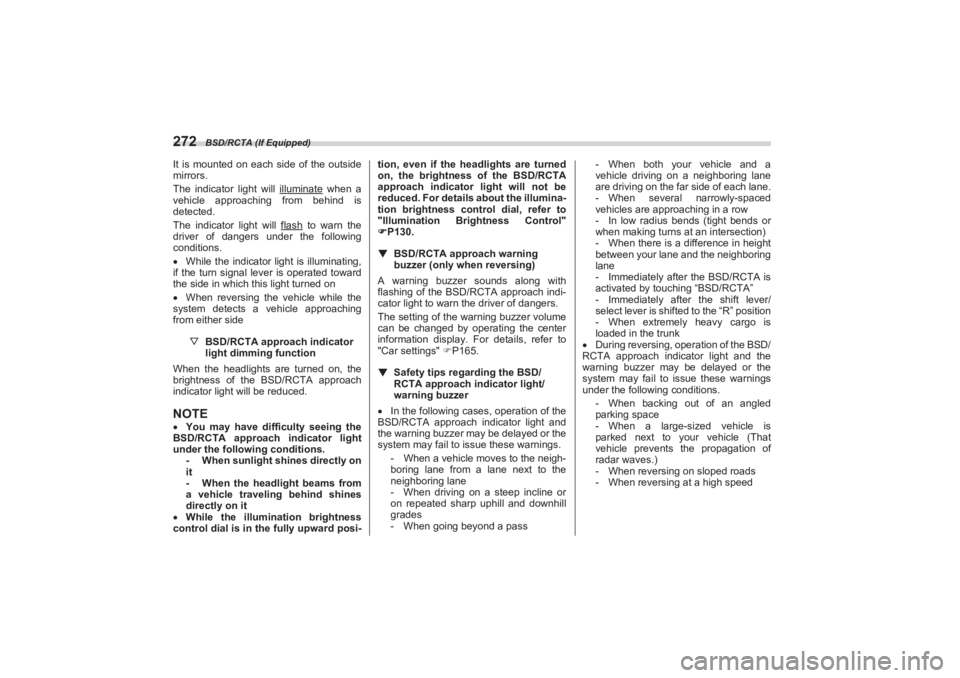
BSD/RCTA (If Equipped)
272It is mounted on each side of the outside
mirrors.
The indicator light will illuminate
when a
vehicle approaching from behind is
detected.
The indicator light will flash
to warn the
driver of dangers under the following
conditions.
While the indicator light is illuminating,
if the turn signal lever is operated toward
the side in which this light turned on
When reversing the vehicle while the
system detects a vehicle approaching
from either side
▽ BSD/RCTA approach indicator
light dimming function
When the headlights are turned on, the
brightness of the BSD/RCTA approach
indicator light will be reduced.
NOTE You may have difficulty seeing the
BSD/RCTA approach indicator light
under the following conditions. - When sunlight shines directly on
it
- When the headlight beams from
a vehicle traveling behind shines
directly on it
While the illumination brightness
control dial is in the fully upward posi- tion, even if the headlights are turned
on, the brightness of the BSD/RCTA
approach indicator light will not be
reduced. For details about the illumina-
tion brightness control dial, refer to
"Illumination Brightness Control"
P130.
▼ BSD/RCTA approach warning
buzzer (only when reversing)
A warning buzzer sounds along with
flashing of the BSD/RCTA approach indi-
cator light to warn the driver of dangers.
The setting of the warning buzzer volume
can be changed by operating the center
information display. For details, refer to
"Car settings" P165.
▼ Safety tips regarding the BSD/
RCTA approach indicator light/
warning buzzer
In the following cases, operation of the
BSD/RCTA approach indicator light and
the warning buzzer may be delayed or the
system may fail to issue these warnings.
- When a vehicle moves to the neigh-
boring lane from a lane next to the
neighboring lane
- When driving on a steep incline or
on repeated sharp uphill and downhill
grades
- When going beyond a pass - When both your vehicle and a
vehicle driving on a neighboring lane
are driving on the far side of each lane.
- When several narrowly-spaced
vehicles are approaching in a row
- In low radius bends (tight bends or
when making turns at an intersection)
- When there is a difference in height
between your lane and the neighboring
lane
- Immediately after the BSD/RCTA is
activated by touching “BSD/RCTA”
- Immediately after the shift lever/
select lever is shifted to the “R” position
- When extremely heavy cargo is
loaded in the trunk
During reversing, operation of the BSD/
RCTA approach indicator light and the
warning buzzer may be delayed or the
system may fail to issue these warnings
under the following conditions.
- When backing out of an angled
parking space
- When a large-sized vehicle is
parked next to your vehicle (That
vehicle prevents the propagation of
radar waves.)
- When reversing on sloped roads
- When reversing at a high speedBRZ_U.book 272 ページ 2022年3月29日 火曜日 午後3時59分